Southern Cross University: MNG10720 Tourism Literature Review
VerifiedAdded on 2023/01/20
|6
|1363
|35
Literature Review
AI Summary
This literature review explores the multifaceted aspects of the tourism and travel industry. It begins by highlighting the industry's significant growth and contribution to global economies, emphasizing its role in foreign exchange, job creation, and cultural awareness. The review delves into the concept of sustainable tourism development, referencing the United Nations Conference on Environment and Development. It examines the diverse components of the tourism supply chain, including accommodation, logistics, restaurants, and infrastructure. Challenges such as globalization, taxation, marketing, infrastructure, and security concerns are addressed. The review also discusses community-based tourism development, environmental management strategies, and the importance of considering economic, social, cultural, and environmental factors in tourism development. The study references various research papers and studies to support its findings, including the work of Harris & Griffin (2012), Krauz (2016), and others, providing a comprehensive overview of the tourism industry's complexities and future directions.
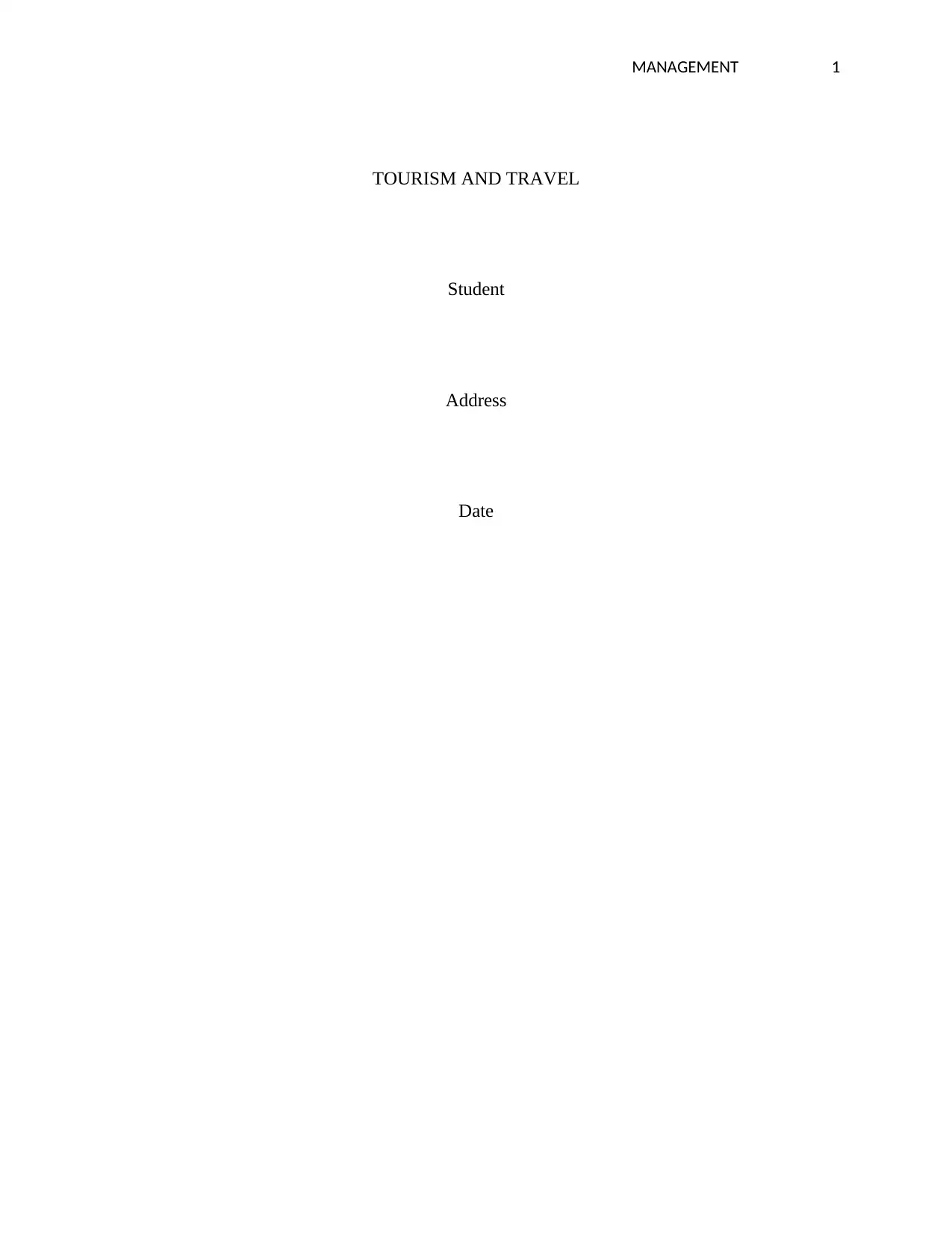
MANAGEMENT 1
TOURISM AND TRAVEL
Student
Address
Date
TOURISM AND TRAVEL
Student
Address
Date
Paraphrase This Document
Need a fresh take? Get an instant paraphrase of this document with our AI Paraphraser
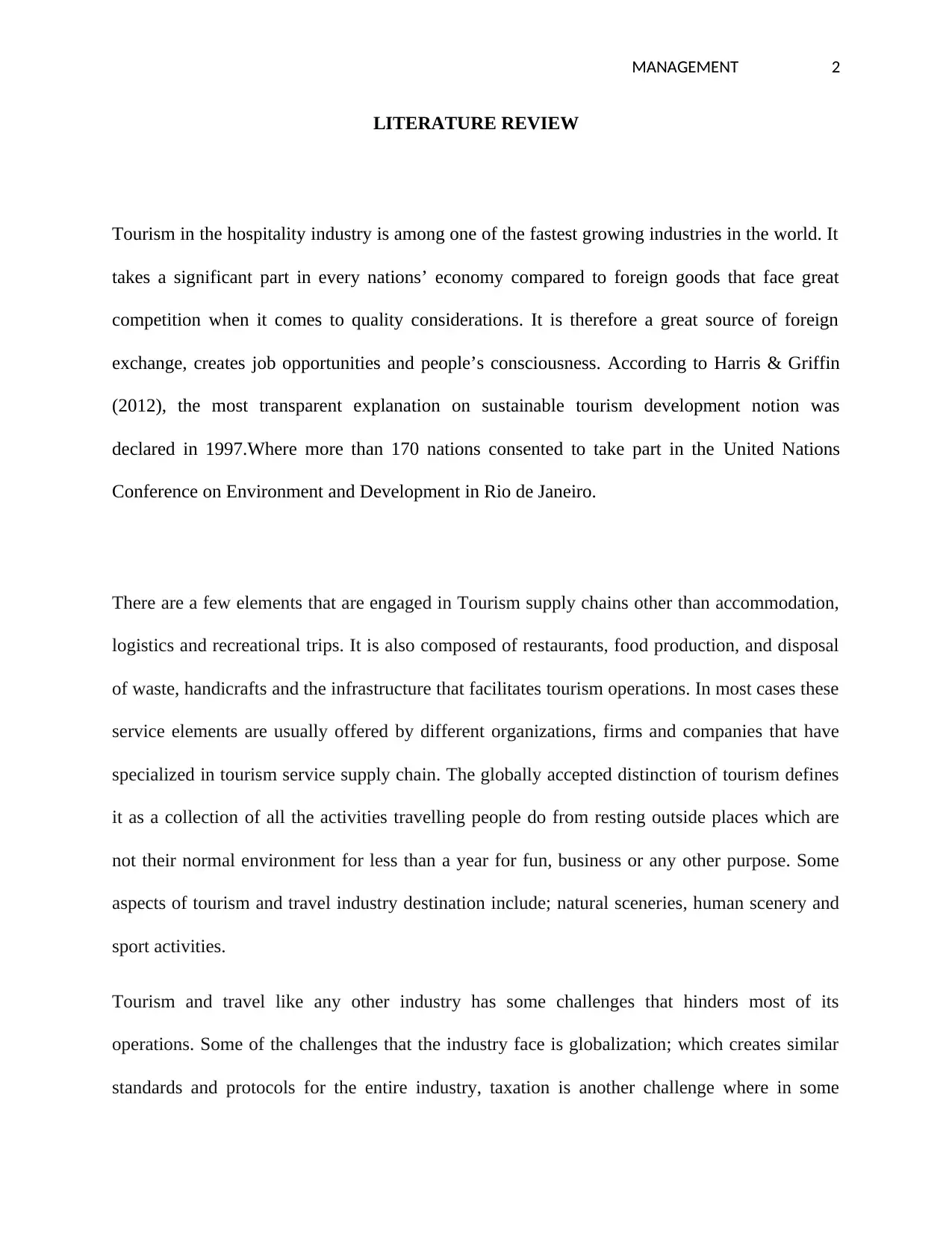
MANAGEMENT 2
LITERATURE REVIEW
Tourism in the hospitality industry is among one of the fastest growing industries in the world. It
takes a significant part in every nations’ economy compared to foreign goods that face great
competition when it comes to quality considerations. It is therefore a great source of foreign
exchange, creates job opportunities and people’s consciousness. According to Harris & Griffin
(2012), the most transparent explanation on sustainable tourism development notion was
declared in 1997.Where more than 170 nations consented to take part in the United Nations
Conference on Environment and Development in Rio de Janeiro.
There are a few elements that are engaged in Tourism supply chains other than accommodation,
logistics and recreational trips. It is also composed of restaurants, food production, and disposal
of waste, handicrafts and the infrastructure that facilitates tourism operations. In most cases these
service elements are usually offered by different organizations, firms and companies that have
specialized in tourism service supply chain. The globally accepted distinction of tourism defines
it as a collection of all the activities travelling people do from resting outside places which are
not their normal environment for less than a year for fun, business or any other purpose. Some
aspects of tourism and travel industry destination include; natural sceneries, human scenery and
sport activities.
Tourism and travel like any other industry has some challenges that hinders most of its
operations. Some of the challenges that the industry face is globalization; which creates similar
standards and protocols for the entire industry, taxation is another challenge where in some
LITERATURE REVIEW
Tourism in the hospitality industry is among one of the fastest growing industries in the world. It
takes a significant part in every nations’ economy compared to foreign goods that face great
competition when it comes to quality considerations. It is therefore a great source of foreign
exchange, creates job opportunities and people’s consciousness. According to Harris & Griffin
(2012), the most transparent explanation on sustainable tourism development notion was
declared in 1997.Where more than 170 nations consented to take part in the United Nations
Conference on Environment and Development in Rio de Janeiro.
There are a few elements that are engaged in Tourism supply chains other than accommodation,
logistics and recreational trips. It is also composed of restaurants, food production, and disposal
of waste, handicrafts and the infrastructure that facilitates tourism operations. In most cases these
service elements are usually offered by different organizations, firms and companies that have
specialized in tourism service supply chain. The globally accepted distinction of tourism defines
it as a collection of all the activities travelling people do from resting outside places which are
not their normal environment for less than a year for fun, business or any other purpose. Some
aspects of tourism and travel industry destination include; natural sceneries, human scenery and
sport activities.
Tourism and travel like any other industry has some challenges that hinders most of its
operations. Some of the challenges that the industry face is globalization; which creates similar
standards and protocols for the entire industry, taxation is another challenge where in some
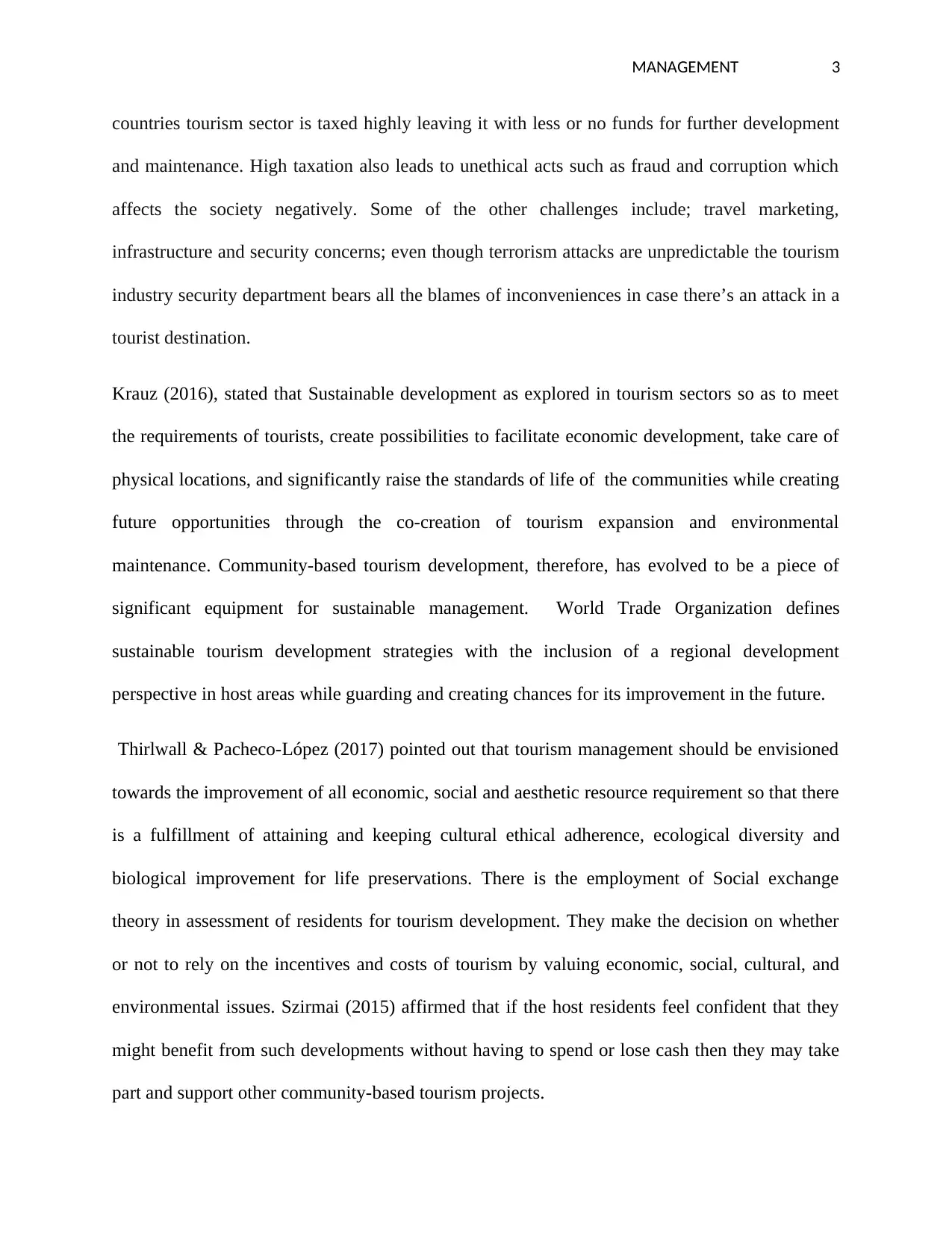
MANAGEMENT 3
countries tourism sector is taxed highly leaving it with less or no funds for further development
and maintenance. High taxation also leads to unethical acts such as fraud and corruption which
affects the society negatively. Some of the other challenges include; travel marketing,
infrastructure and security concerns; even though terrorism attacks are unpredictable the tourism
industry security department bears all the blames of inconveniences in case there’s an attack in a
tourist destination.
Krauz (2016), stated that Sustainable development as explored in tourism sectors so as to meet
the requirements of tourists, create possibilities to facilitate economic development, take care of
physical locations, and significantly raise the standards of life of the communities while creating
future opportunities through the co-creation of tourism expansion and environmental
maintenance. Community-based tourism development, therefore, has evolved to be a piece of
significant equipment for sustainable management. World Trade Organization defines
sustainable tourism development strategies with the inclusion of a regional development
perspective in host areas while guarding and creating chances for its improvement in the future.
Thirlwall & Pacheco-López (2017) pointed out that tourism management should be envisioned
towards the improvement of all economic, social and aesthetic resource requirement so that there
is a fulfillment of attaining and keeping cultural ethical adherence, ecological diversity and
biological improvement for life preservations. There is the employment of Social exchange
theory in assessment of residents for tourism development. They make the decision on whether
or not to rely on the incentives and costs of tourism by valuing economic, social, cultural, and
environmental issues. Szirmai (2015) affirmed that if the host residents feel confident that they
might benefit from such developments without having to spend or lose cash then they may take
part and support other community-based tourism projects.
countries tourism sector is taxed highly leaving it with less or no funds for further development
and maintenance. High taxation also leads to unethical acts such as fraud and corruption which
affects the society negatively. Some of the other challenges include; travel marketing,
infrastructure and security concerns; even though terrorism attacks are unpredictable the tourism
industry security department bears all the blames of inconveniences in case there’s an attack in a
tourist destination.
Krauz (2016), stated that Sustainable development as explored in tourism sectors so as to meet
the requirements of tourists, create possibilities to facilitate economic development, take care of
physical locations, and significantly raise the standards of life of the communities while creating
future opportunities through the co-creation of tourism expansion and environmental
maintenance. Community-based tourism development, therefore, has evolved to be a piece of
significant equipment for sustainable management. World Trade Organization defines
sustainable tourism development strategies with the inclusion of a regional development
perspective in host areas while guarding and creating chances for its improvement in the future.
Thirlwall & Pacheco-López (2017) pointed out that tourism management should be envisioned
towards the improvement of all economic, social and aesthetic resource requirement so that there
is a fulfillment of attaining and keeping cultural ethical adherence, ecological diversity and
biological improvement for life preservations. There is the employment of Social exchange
theory in assessment of residents for tourism development. They make the decision on whether
or not to rely on the incentives and costs of tourism by valuing economic, social, cultural, and
environmental issues. Szirmai (2015) affirmed that if the host residents feel confident that they
might benefit from such developments without having to spend or lose cash then they may take
part and support other community-based tourism projects.
⊘ This is a preview!⊘
Do you want full access?
Subscribe today to unlock all pages.

Trusted by 1+ million students worldwide
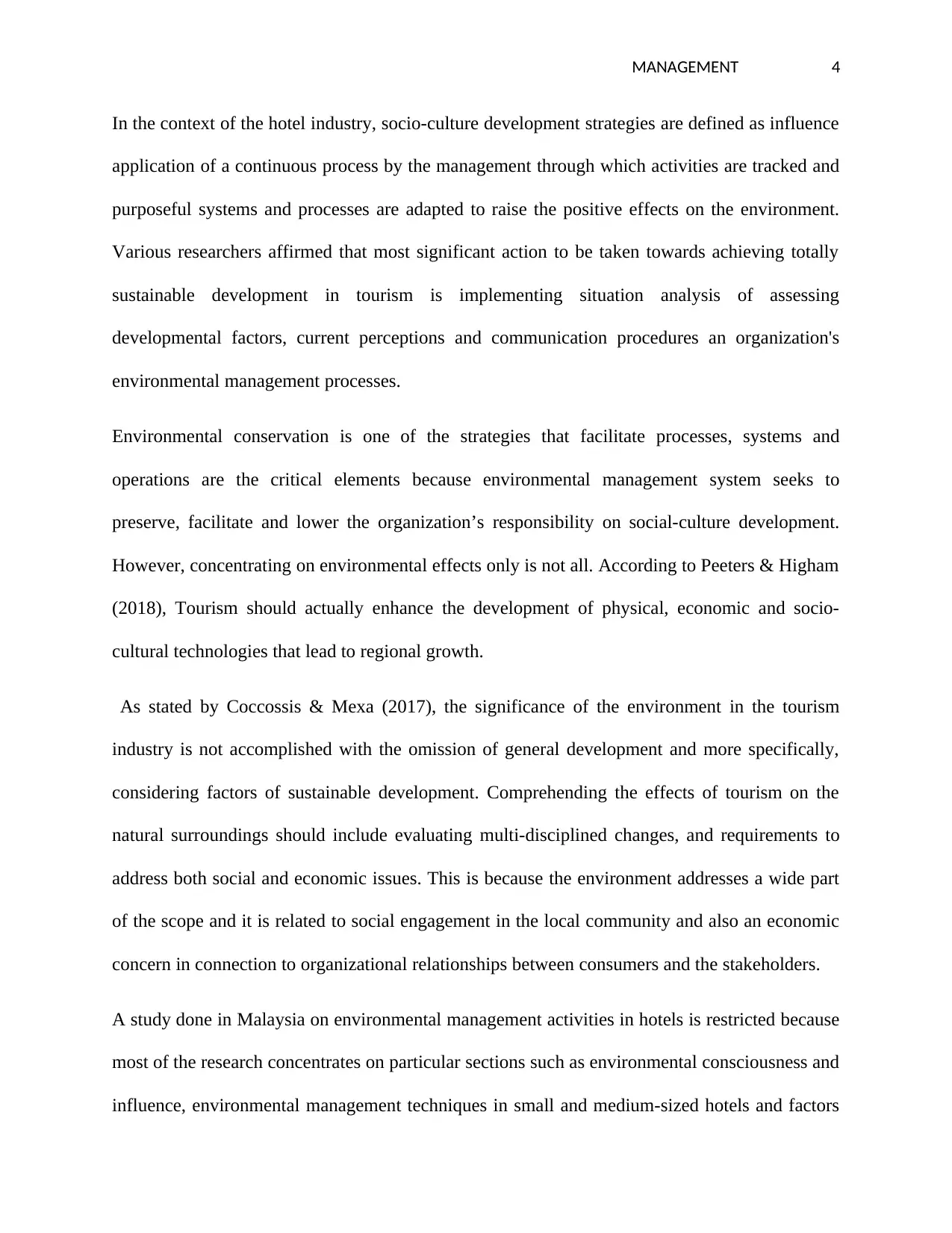
MANAGEMENT 4
In the context of the hotel industry, socio-culture development strategies are defined as influence
application of a continuous process by the management through which activities are tracked and
purposeful systems and processes are adapted to raise the positive effects on the environment.
Various researchers affirmed that most significant action to be taken towards achieving totally
sustainable development in tourism is implementing situation analysis of assessing
developmental factors, current perceptions and communication procedures an organization's
environmental management processes.
Environmental conservation is one of the strategies that facilitate processes, systems and
operations are the critical elements because environmental management system seeks to
preserve, facilitate and lower the organization’s responsibility on social-culture development.
However, concentrating on environmental effects only is not all. According to Peeters & Higham
(2018), Tourism should actually enhance the development of physical, economic and socio-
cultural technologies that lead to regional growth.
As stated by Coccossis & Mexa (2017), the significance of the environment in the tourism
industry is not accomplished with the omission of general development and more specifically,
considering factors of sustainable development. Comprehending the effects of tourism on the
natural surroundings should include evaluating multi-disciplined changes, and requirements to
address both social and economic issues. This is because the environment addresses a wide part
of the scope and it is related to social engagement in the local community and also an economic
concern in connection to organizational relationships between consumers and the stakeholders.
A study done in Malaysia on environmental management activities in hotels is restricted because
most of the research concentrates on particular sections such as environmental consciousness and
influence, environmental management techniques in small and medium-sized hotels and factors
In the context of the hotel industry, socio-culture development strategies are defined as influence
application of a continuous process by the management through which activities are tracked and
purposeful systems and processes are adapted to raise the positive effects on the environment.
Various researchers affirmed that most significant action to be taken towards achieving totally
sustainable development in tourism is implementing situation analysis of assessing
developmental factors, current perceptions and communication procedures an organization's
environmental management processes.
Environmental conservation is one of the strategies that facilitate processes, systems and
operations are the critical elements because environmental management system seeks to
preserve, facilitate and lower the organization’s responsibility on social-culture development.
However, concentrating on environmental effects only is not all. According to Peeters & Higham
(2018), Tourism should actually enhance the development of physical, economic and socio-
cultural technologies that lead to regional growth.
As stated by Coccossis & Mexa (2017), the significance of the environment in the tourism
industry is not accomplished with the omission of general development and more specifically,
considering factors of sustainable development. Comprehending the effects of tourism on the
natural surroundings should include evaluating multi-disciplined changes, and requirements to
address both social and economic issues. This is because the environment addresses a wide part
of the scope and it is related to social engagement in the local community and also an economic
concern in connection to organizational relationships between consumers and the stakeholders.
A study done in Malaysia on environmental management activities in hotels is restricted because
most of the research concentrates on particular sections such as environmental consciousness and
influence, environmental management techniques in small and medium-sized hotels and factors
Paraphrase This Document
Need a fresh take? Get an instant paraphrase of this document with our AI Paraphraser
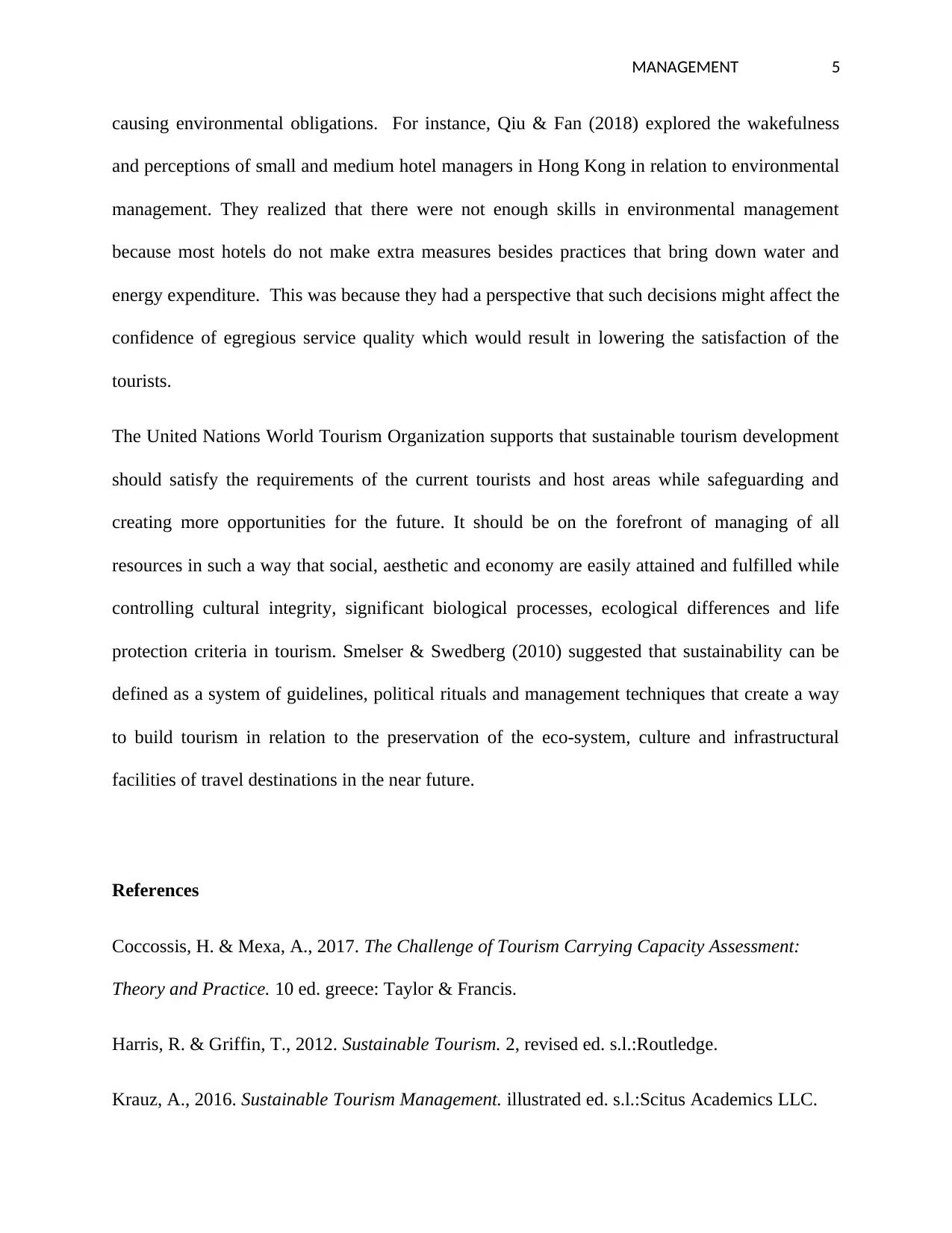
MANAGEMENT 5
causing environmental obligations. For instance, Qiu & Fan (2018) explored the wakefulness
and perceptions of small and medium hotel managers in Hong Kong in relation to environmental
management. They realized that there were not enough skills in environmental management
because most hotels do not make extra measures besides practices that bring down water and
energy expenditure. This was because they had a perspective that such decisions might affect the
confidence of egregious service quality which would result in lowering the satisfaction of the
tourists.
The United Nations World Tourism Organization supports that sustainable tourism development
should satisfy the requirements of the current tourists and host areas while safeguarding and
creating more opportunities for the future. It should be on the forefront of managing of all
resources in such a way that social, aesthetic and economy are easily attained and fulfilled while
controlling cultural integrity, significant biological processes, ecological differences and life
protection criteria in tourism. Smelser & Swedberg (2010) suggested that sustainability can be
defined as a system of guidelines, political rituals and management techniques that create a way
to build tourism in relation to the preservation of the eco-system, culture and infrastructural
facilities of travel destinations in the near future.
References
Coccossis, H. & Mexa, A., 2017. The Challenge of Tourism Carrying Capacity Assessment:
Theory and Practice. 10 ed. greece: Taylor & Francis.
Harris, R. & Griffin, T., 2012. Sustainable Tourism. 2, revised ed. s.l.:Routledge.
Krauz, A., 2016. Sustainable Tourism Management. illustrated ed. s.l.:Scitus Academics LLC.
causing environmental obligations. For instance, Qiu & Fan (2018) explored the wakefulness
and perceptions of small and medium hotel managers in Hong Kong in relation to environmental
management. They realized that there were not enough skills in environmental management
because most hotels do not make extra measures besides practices that bring down water and
energy expenditure. This was because they had a perspective that such decisions might affect the
confidence of egregious service quality which would result in lowering the satisfaction of the
tourists.
The United Nations World Tourism Organization supports that sustainable tourism development
should satisfy the requirements of the current tourists and host areas while safeguarding and
creating more opportunities for the future. It should be on the forefront of managing of all
resources in such a way that social, aesthetic and economy are easily attained and fulfilled while
controlling cultural integrity, significant biological processes, ecological differences and life
protection criteria in tourism. Smelser & Swedberg (2010) suggested that sustainability can be
defined as a system of guidelines, political rituals and management techniques that create a way
to build tourism in relation to the preservation of the eco-system, culture and infrastructural
facilities of travel destinations in the near future.
References
Coccossis, H. & Mexa, A., 2017. The Challenge of Tourism Carrying Capacity Assessment:
Theory and Practice. 10 ed. greece: Taylor & Francis.
Harris, R. & Griffin, T., 2012. Sustainable Tourism. 2, revised ed. s.l.:Routledge.
Krauz, A., 2016. Sustainable Tourism Management. illustrated ed. s.l.:Scitus Academics LLC.
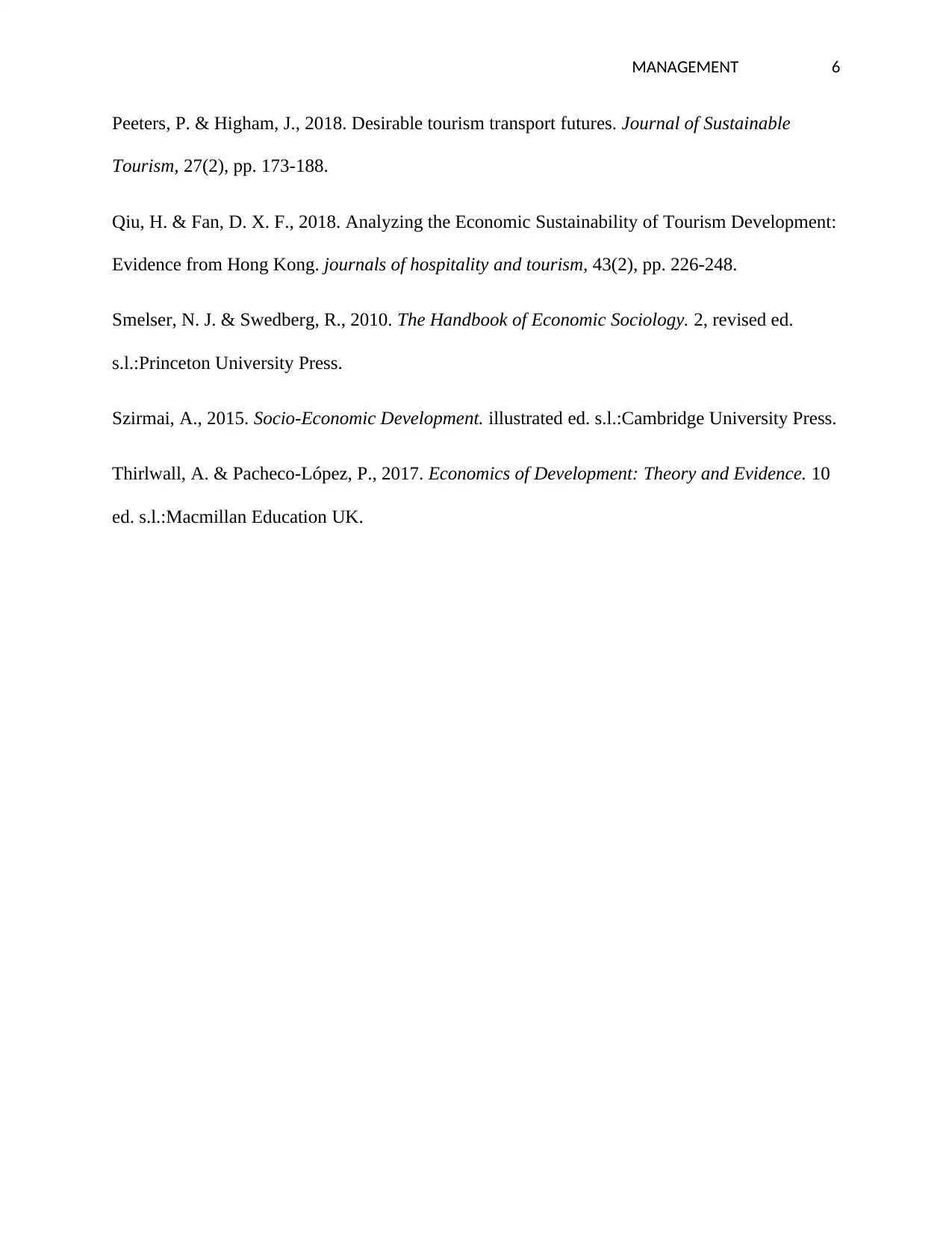
MANAGEMENT 6
Peeters, P. & Higham, J., 2018. Desirable tourism transport futures. Journal of Sustainable
Tourism, 27(2), pp. 173-188.
Qiu, H. & Fan, D. X. F., 2018. Analyzing the Economic Sustainability of Tourism Development:
Evidence from Hong Kong. journals of hospitality and tourism, 43(2), pp. 226-248.
Smelser, N. J. & Swedberg, R., 2010. The Handbook of Economic Sociology. 2, revised ed.
s.l.:Princeton University Press.
Szirmai, A., 2015. Socio-Economic Development. illustrated ed. s.l.:Cambridge University Press.
Thirlwall, A. & Pacheco-López, P., 2017. Economics of Development: Theory and Evidence. 10
ed. s.l.:Macmillan Education UK.
Peeters, P. & Higham, J., 2018. Desirable tourism transport futures. Journal of Sustainable
Tourism, 27(2), pp. 173-188.
Qiu, H. & Fan, D. X. F., 2018. Analyzing the Economic Sustainability of Tourism Development:
Evidence from Hong Kong. journals of hospitality and tourism, 43(2), pp. 226-248.
Smelser, N. J. & Swedberg, R., 2010. The Handbook of Economic Sociology. 2, revised ed.
s.l.:Princeton University Press.
Szirmai, A., 2015. Socio-Economic Development. illustrated ed. s.l.:Cambridge University Press.
Thirlwall, A. & Pacheco-López, P., 2017. Economics of Development: Theory and Evidence. 10
ed. s.l.:Macmillan Education UK.
⊘ This is a preview!⊘
Do you want full access?
Subscribe today to unlock all pages.

Trusted by 1+ million students worldwide
1 out of 6
Related Documents
Your All-in-One AI-Powered Toolkit for Academic Success.
+13062052269
info@desklib.com
Available 24*7 on WhatsApp / Email
![[object Object]](/_next/static/media/star-bottom.7253800d.svg)
Unlock your academic potential
Copyright © 2020–2025 A2Z Services. All Rights Reserved. Developed and managed by ZUCOL.


